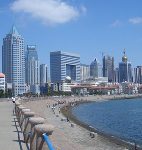[Produced in association with Rutgers Climate and Social Policy Initiative]
Abundant resources and easy transportation make coastal areas some of the most densely populated in the world. While low-lying, coastal areas represent only 2% of the land on the globe, they are home to 13% of the world’s population and 65% of cities with a population of 5 million or more. Meanwhile, a United Nations study concluded that these cities are at high risk for typhoons and hurricanes, floods, landslides and drought.
Despite low levels of urbanisation, the percentage of the population living in coastal cities in Africa and Asia is already higher than that in North America and Europe. Three quarters of the world’s population of low-lying, coastal areas are in Asia, along with two thirds of the global urban population. These statistics indicate that many developing nations are at greater risk of rising sea levels, typhoons and tsunamis. The 2008 World Disasters Report from the International Red Cross points out that in 2007 Asia suffered 15 disasters affecting more than 1 million people. Floods have affected 1 hundred million people in China and over 10 million people in India and Bangladesh. In May this year, half the population of Burma was affected by a tropical storm that left 80 thousand dead.
China has a long coastline and 30% of it is low-lying. Over 70% of large cities, more than half of the population and over 70% of industrial and agricultural production are located in the eastern and coastal areas of the country. These richer and more developed regions are vulnerable to disasters such as floods and typhoons. An Organisation for Economic Cooperation and Development (OECD) report ranked coastal cities at risk from flooding in terms of population, value of property and infrastructure. A number of Chinese cities — including Guangzhou, Shenzhen, Shanghai and Haikou — were ranked in the top 20. These developed cities have already shown themselves to be highly vulnerable to ever more frequent climate disasters. Since June 2008, these places have seen torrential rain unknown for decades along with flooding that has caused huge economic losses. As extreme weather has also become more common in inland China, coastal cities are not the only places at risk. In July 2007, Chongqing was struck by the most violent thunderstorm experienced in 115 years, while Jinan saw the heaviest downpour in recorded history (See photo below).
Many cities are unable to take any action to prevent these disasters, and the losses are huge. Even those cities known for their pleasant climates have shown themselves unable to cope with climate change. In July 2008, a downpour paralysed 80% of the traffic in Kunming — also known as the “Spring City” — and forced its airport to close for eight hours.
Excessive urbanisation has made developing nations and cities more vulnerable to climate change. However, urban environmental infrastructure and disaster-prevention abilities have not kept up with urban growth. Many Chinese cities have built transportation and power infrastructure as they have grown, but their environmental infrastructure has yet to be addressed. Aging waste water systems and the mixing of waste and rainwater present huge dangers in these places. Some cities, such as Jinan and Chongqing, still have inappropriate urban zoning inherited from earlier times, which worsens their ecological and environmental risks.
The huge demand for labour has attracted many immigrants to Chinese cities, outstripping these urban centres’ ability to accommodate them. These newcomers are concentrated where the cities and out-lying areas meet, which is also where the provision of drainage and waste removal are not available. When disaster strikes, these situations will worsen the effects of the crisis.
The effects of urbanisation and industrialisation on the movement of labour have also increased the risks from climate change. In China, surplus village labour often relocates from resource-poor regions to the more developed coast. This situation has provided the workforce to enable export-led economic growth, but has also resulted in the over-population of coastal regions. During the Chinese New Year of 2008, just as these workers were returning to their homes for the holiday, the south of China was struck by blizzards and sub-zero temperatures. Railways and roads were paralysed and millions were trapped in train stations. To reduce the potential vulnerabilities of coastal cities, China needs to reconsider its externally-driven mode of economic growth, diversify the ways in which labour moves and take measures to move labour from the coast to inland economic centres.
In the face of worsening climate change dangers, China’s cities face more than just urban planning and disaster prevention and response issues. More analysis is necessary to determine the failings of China’s urbanisation process that takes into account an overall strategy for both economic and population growth. This process would facilitate a general strengthening of China’s ability to respond to disasters and prevent many single incidents that could have the potential to begin a domino effect. This type of research also would be the most meaningful to consider China’s urbanisation process.
Zheng Yan is an economics PhD working at the Chinese Academy of Social Sciences Research’s Centre for Sustainable Development.
Produced in association with:
Homepage photo by Lakerae





